"Dont touch me"
foreword
Reader, ponder these lines! In the Soviet navy there were famous battleships, cruisers, destroyers. But not many were honored with the memory and respect of ordinary sailors!
Several years passed after the war, and once, in the daytime, everyday and inconspicuous, tugs introduced a strange structure into the North Bay of Sevastopol - a kind of large iron box.
The caravan followed by the cruisers who stood under the pairs of gray communities and unwittingly attracted attention. Sailors watched the ships from the sides of the ships. Tale in white canvas robes, chubby, meticulous.
- What is the thing, guys? It seems to be like a ship, but no stern, no bow ...
- Look at - anti-aircraft guns! One, two ... four! Seventy six millimeters! And the spotlight in the corner, broken ... A strange vessel ...
- You yourself are a “dish”! Look
The sides of the iron box that was sliding by, carried the black burners on themselves — traces of the old fire and smoke, trusting in the towing dogs, were glancing at the light with broken eye sockets of the portholes ...
The conversations themselves were silent. And it was obvious to those who did not fight that the iron box honestly lived its navy age. Seasoned officers and foremen immediately recognized her:
- This is a floating battery! The famous "Do not touch me!".
- Legend, not a ship ... To tell - you won't believe ...
And then, first on one, then on the other, and so on all the ships, the commands were given “to attention, take off the headgear”. Hooters sounded over the bay, the sailors stopped at attention, the officers took the peak, greeting the floating battery passing by ...
Columbine
This time I want to talk about the strangest warship of the Soviet Navy. He is not mentioned in any reference book on the Navy, although it is precisely this ship that holds a unique combat record. They were shot down more than all the Nazi planes - 24 for nine months (for 16, downed aircraft were given the title Hero of the Soviet Union to the pilots). None of our ship has achieved more. This is a floating anti-aircraft battery №3 "Do not touch me."
Before the war, the construction of new battleships of the 23 project began at all the largest shipyards. At the Baltic plant "Soviet Union", at the plant named after A. Marty (Nikolaev) "Soviet Ukraine", in Molotovsk (Severodvinsk), at the Sevmashzavod "Soviet Belorussia". In Nikolaev, an experimental compartment was created, which is the middle part of the citadel of future battleships, with a deck area of about 800 square. meters After the end of the trials on seaworthiness, accidents and survivability, the compartment was placed at the pier of Troitskaya gully, where he stood until the beginning of World War II.
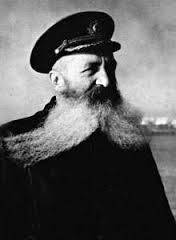 The hereditary sailor, captain of the 3 rank, Butakov Grigori Andreevich, G.А. Butakov belonged to the famous dynasty of naval officers Butakov, leading his lineage from the time of Peter the Great, and was the grandson of Admiral Grigory Ivanovich Butakov, the hero of the First Defense of Sevastopol 2-1854, founder of the tactics of the armored fleet. It was Grigory Andreyevich who had the idea to equip a rusty, with the sides pierced, the Linkor compartment under the floating anti-aircraft battery for air defense of Sevastopol from the sea direction. Comflot F.S. The October supported the report of the captain of the 1855 rank, and the People's Commissar of the Navy N.G. Kuznetsov approved this idea.
The hereditary sailor, captain of the 3 rank, Butakov Grigori Andreevich, G.А. Butakov belonged to the famous dynasty of naval officers Butakov, leading his lineage from the time of Peter the Great, and was the grandson of Admiral Grigory Ivanovich Butakov, the hero of the First Defense of Sevastopol 2-1854, founder of the tactics of the armored fleet. It was Grigory Andreyevich who had the idea to equip a rusty, with the sides pierced, the Linkor compartment under the floating anti-aircraft battery for air defense of Sevastopol from the sea direction. Comflot F.S. The October supported the report of the captain of the 1855 rank, and the People's Commissar of the Navy N.G. Kuznetsov approved this idea.In July, the 1941 of the year on the “square” (as the compartment was called in official documents) began the installation of general ship systems and the installation of weapons. And on August 3, the naval flag was hoisted on a separate floating battery No. XXUMX. By order of the Commander of the Black Sea Fleet from 1941 of August, she was incorporated into the Protection of the Water District of the Main Base.
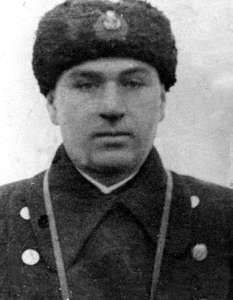 The commander of the floating battery No. XXUMX was appointed senior lieutenant Sergey Yakovlevich Moshensky (the flagship specialist of the fleet's anti-aircraft artillery), military commander — senior political instructor Nestor S. Sereda (military commissar of the 3-th anti-aircraft battery). The crew of the floating battery consisted of 54 people (according to other data of 130), 150 of them were called up from the reserve, the rest were recruited from all parts and ships of the Black Sea Fleet. The commanders of the batteries were young lieutenants, recent graduates of the Black Sea Higher Naval School.
The commander of the floating battery No. XXUMX was appointed senior lieutenant Sergey Yakovlevich Moshensky (the flagship specialist of the fleet's anti-aircraft artillery), military commander — senior political instructor Nestor S. Sereda (military commissar of the 3-th anti-aircraft battery). The crew of the floating battery consisted of 54 people (according to other data of 130), 150 of them were called up from the reserve, the rest were recruited from all parts and ships of the Black Sea Fleet. The commanders of the batteries were young lieutenants, recent graduates of the Black Sea Higher Naval School.The artillery of the floating battery №3 was reduced to three gun batteries:
- Two 130-mm gun mounts B-13 (supplied from the arsenal), battery commander - Lieutenant Mikhail Z. Lopatko; in the ammunition ammunition included "diving" shells to combat submarines;
- four 76,2-mm anti-aircraft gun installations 34-K, battery commander - Lieutenant Semen Abramovich Heeger;
- Three 37-mm anti-aircraft gun 70-K, the commander of the battery - Lieutenant Nikolai Danshin;
- three 12,7-mm anti-aircraft guns DShK.
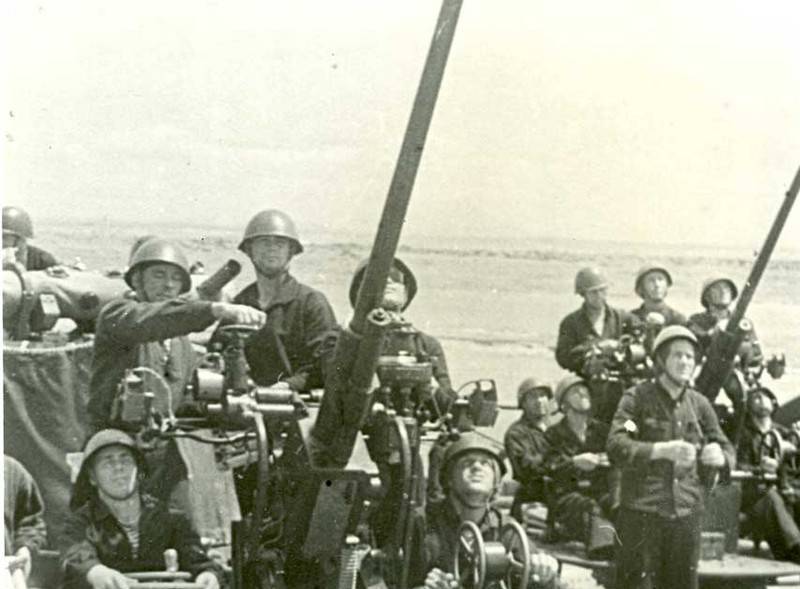
Sailors have always been famous for the severity of their language and soon the “square” playfully began to call “Columbine”. History The appearance of the name “Don't touch me” has two options.
Official: the battery is named after the armored floating battery "Do not touch me" which was part of the Russian fleet in the second half of the XIX century. Unofficial: a song was born on the floating battery shortly after its launch.
“Do not touch me fascist, damn!
And if you break the sky quiet,
From my ardent embrace
You can't fly back alive! ”
According to the first words of this song, the battery began to be called: "Don't touch me."
The Germans called the floating battery number XXUMX "Carry, O Lord," and "Square of Death."
9 August sounded the traditional naval team "To prepare the floating battery for the battle and the march" (oh, what a song it was: "Back with a tank, on a yacht, on a waist. From the anchor and mooring line!” - Serg65. The tugs began to take out the battery to an external raid, a “happy journey” signal appeared on the signal mast of Konstantinovsky Ravelin, and after the passage of the boom, the tugs turned towards Kacha (in Soviet times there was an 3-I anchorage point). As soon as he got up on the dead anchor and released the tugs, a combat alarm sounded on the battery. From the sea, 6 U-88 went to Sevastopol, the first combat shooting was unsuccessful, the Junkers cleverly left the shelling zone. The parking lot of the battery was enclosed by several rows of anti-submarine networks. The floating battery solved problems in close cooperation with the second division of the 61 artillery regiment. Communication between the command post and the battery was carried out by radio.
After the battle of 9 in August, the Germans estimated the value of the new floating battery of Russians and 18 of August. 1941 of the year made a raid directly on the battery. The 9 bombardment of the Ju-88 bombers was reflected, during which 36 bombs were dropped on the battery.
31 August 1941 of the year 10 25 hours of minutes at a distance of 21 kb battery signallers noticed the periscope of a submarine. The battery opened fire with 130-mm guns, making 15 shots with diving shells. In 16.27, the 300 ° bearing on the 50 kB battery distance from the battery was observed to have a big blast.
On guard of Chersonesus airfield
In early November 1941, severe storms began on the Black Sea. The efforts of the stanchion anchor were not enough to hold the floating battery in place and with waves it began to beat ashore, which was already occupied by German troops. In addition, the accuracy of fire battery gunners in conditions of high excitement significantly decreased. At the suggestion of N. A. Ostryakov, who was recently appointed to the position of the Commander of the Air Force of the Black Sea Fleet, it was decided to change the parking place of the "square". On the night of 10 on 11 in November 1941, the sea tugs SP-13 and SP-14 transferred the battery to Cossack Bay and were stranded to give it greater stability. The command before the crew was assigned a new task - to cover the Chersonesus airfield with anti-aircraft fire.
In the afternoon of November 29, the 1941 anti-aircraft gunners No. XXNX won their first victory - the Bf-3 fighter was shot down, which fell ashore.
14 January 1942, the battery gunners chalked up another Ju-88, the plane fell into the sea. Total for this day, reflecting the attacks of the enemy aircraft, according to the commander's report was spent ammunition caliber 76,2 mm - 193 shots, 37-mm - 606 shots, ammunition for machine guns DShK - 456 shots.
3 March 1942, battery gun fire shot down Non-111.
In March, 1942, battery commander S.Ya. Moshensky was awarded the next military rank of lieutenant commander, and for his military service he was awarded the Order of the Red Banner. Awards for the downed aircraft and other crew members.
9 June 1942 of the year in 14.13 a floating battery No. 3 was bombarded with three visits from a dive three aircraft of the enemy Ju-88. During the third approach, a direct hit of an 76,2-mm projectile hit one aircraft, which dropped sharply, lost speed and fell into the sea at a distance of 110 kb. From 14.45 to 15.00, while repelling a raid on the airfield of a large group of Ju-88 enemy planes (up to 40 machines), coming from Balaklava at 4200 meters and diving during bombing to 1800-2500 meters, good gaps and straight lines were observed from the battery Hitting 76,2 mm shells and 37 mm machine guns. One plane, which received a direct hit into the fuselage near the wings, sharply turned its back and fell into the sea even before the start of the dive. The second plane, which received two lines of direct hits from 37-mm automata, fell into the sea. During the shooting, 76,2-mm shrapnel - 95 pieces, 76,2-mm distance grenades - 235 pieces, 37-mm frag-tracer grenades - 371 piece, ammunition for DShK machine guns - 291 piece were spent. Losses and damage the battery did not have. For 76,2-mm caliber guns, only the 602 shot was left.
12 June 1942 of the year in 19 hours 30 minutes artillery fire battery shot down Bf-109, attempting to attack the landing IL-2. The damaged enemy fighter, accompanied by two Bf-109s, headed for Belbek and later fell in the Uchkuevka area. In this episode, I will focus in more detail.
From the memoirs of the Hero of the Soviet Union, Colonel Miron Efimovich Efimov.
"... the terrain is familiar to the smallest details. We went along this route dozens of times. The road to Sevastopol goes to the left, the hills below and the front positions of our troops follow them.
German Tanks we noticed immediately. True, there were fewer than anticipated. Maybe there really were more of them before, but now, only two went to Sevastopol, lazily firing.
I gave Turgenev a signal: “You work on the second! We attack! "
We rushed down. The cannon tracks made the road better, dug into the tanks ... I pulled the attack aircraft out of attack, looked around. The tanks were burning. According to the unwritten Sevastopol tradition, we passed over the nearest section of our leading positions. We noticed the German infantrymen gathering under the mountain. Proshturmovali. Walked through the fire. Apparently, they threw off the planned attack: the Nazis, like cockroaches, scattered through craters and crevices ...
coming out of the dive, I abruptly threw the car to the side. It was an old, well-received reception. After all, just that I attacked and my attention was riveted to the battlefield, which means that for a while I had no opportunity to follow what was happening in the air behind my back. Precaution saved my life! There, where my assault attacker was a moment ago, a cannon line went through. We were joined by the "Messers." Looking back, he remarked: there are four of them following me. And for Turgenev - no less ...
I threw the plane from side to side, described the arc, made zigzags. He did everything so that the attacking "Messers" did not guess my next maneuver, did not squeeze them into ticks ... Cossack Bay, an airfield appeared, but it was impossible to sit down ... "Messers" did not lag behind. They wanted to destroy me during the landing. What to do?
I make a turn, below the bay mirror and suddenly a saving thought: go to the floating battery! To descend, pass over it, and if the Messers get in touch, the batterymen will surely cut them off with fire, knock them off course, and in the meantime, they will be able to sit down!
I went to the floating battery. Here it is, almost square, a matchbox-sized iron box. Below, lower! Here the battery is already the size of a book. The battery increased in size. People are already clearly visible near guns and machine guns ... Barrels of guns are turned in my direction. A thought flashed: “Would they take over the German?” He flapped his wings ...
swept over the battery. I saw the faces of the people quite clearly for a moment. I noticed smoke - a shot of one of the guns. The coast was approaching, and that was the landing strip. Going upwind - no time. It’s also impossible to wait until the next German long-range projectile that breaks down exactly in 40 seconds at the airfield ...
.... Now, remembering the past, I can say with full responsibility, testify: on that day, the floating battery number 3, the legendary “Do not touch me!” Saved my life. "
June 19, 1942 on "Don't Touch Me!" the next 450th German attack was carried out aviation. Due to lack of ammunition for guns, German pilots managed to break through to the battery. At 20.20 one of the bombs hit the port side of the “square”, the second exploded right on the side. The crews of anti-aircraft guns and machine guns were killed or wounded, a fire broke out in the aft artillery cellar, which, however, was managed to be put out. The battery commander was mortally wounded, 28 crew members were killed. 27 sailors were wounded, who were transported ashore by boat. By evening, the crew managed to put into operation a 37-mm machine gun and two DShK machine guns, but there was practically no ammunition for them.
25 June 1942 of the year on the battery of ammunition were only cartridges for machine guns and several clips for 37-mm anti-aircraft guns. On this day, the No. 27NNBB Tub battery was destroyed by Ju-3 crew of lieutenant Ernst Hinrichs from the 88 squadron of the KG 2 squadron "Edelweiss". For this victory, Hinrichs was immediately presented to the Knight's Cross, which received July 51 25.
By 26 June 1942, the battery number 3 remained less than half of the existing barrels and personnel. The heavily wounded, among them was Commissioner N. S. Sereda, was sent to Kamyshovaya Bay. And on June 27 of 1942, according to the order of Rear Admiral V. Fadeev, the floating battery No. XXUMX was disbanded. The sailors went ashore and joined the marines that defended the Chersonese airfield and the 3 th coastal battery. The wounded were taken to the mainland ships of the Black Sea Fleet. 35 July 1, the year Sevastopol fell ...
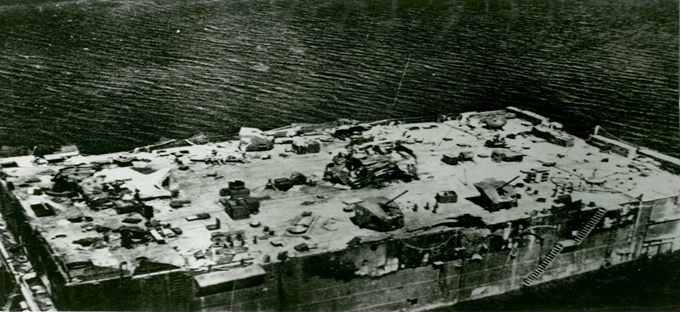
Finale
The mortally wounded captain-lieutenant Moshensky S. I was sent by boat to the shore, where he died in the medical battalion in Kamyshovaya Bay. The burial site is not known, but it can be assumed that this place is in the area of the current "Admiral Lagoon" and the former Cologne missile unit.
Battery Commissioner Sereda N.S. was seriously injured. The wounded was carried out by the surviving sailors. On the leader "Tashkent" was delivered to Novorossiysk. He was treated in hospitals. After the war he lived in Sevastopol, served on the Black Sea Fleet until the 1954 year. He retired with the rank of colonel. He passed away in 1984 year. Buried on Dergachi.
Dead seamen were killed buried at sea.
From the notebook of the downed Nazi pilot Helmut Wintzel:
"Yes, my friend Max did not return from the death square. Before that, Wiley, Paul, and others did not return. We lost 10 airplanes in this square. The same number returned wounded. To fly there means dying. The fire of this battery is amazingly marking, terrible and merciless. What kind of people are there who shoot down our pilots with several shots? "
From the book "Wolfgang Dietrich" Bomber Squadron "Edelweiss":
"At this time, I./KG51 operated together with the VIII air corps under the command of General Oberst Wolfram von Richthofen. One of her successes is worth mentioning because thousands of German soldiers could watch him from the stands at the heights around the North Bay in Sevastopol.
For weeks, a floating anti-aircraft battery with 164 cannons mounted on it, anchored in North Bay, directly beside a large lighthouse at Cape Chersonese, fired a destructive force. She prevented German ground, sea and air forces from conducting effective attacks on the strongholds of the fortress. Regardless of where the bombers flew from, from Tiraspol, China or Sarabuz, this floating anti-aircraft battery was a real pain for them - and at the same time very unpleasant ... "
The best reward of a warrior is the fear of the enemy, the Germans with a fright on the rectangle with the dimensions 20x40 meters of whole 164 guns stuck!
German cruiser air defense "Niobe", armament:
- 105-mm guns, 8 pcs .;
- 40-mm anti-aircraft guns, 25 units;
- Radar.
The bridge and superstructures are protected by armor, the deck is covered with a thick layer of concrete, the crew of the 350 man, had the opportunity to maneuver. 16 sunk July 1944 year in the Finnish port of Kotka.
The 26 aircraft flew directly into the cruiser, the raid continued 8 minutes, the 88 aerial bombs dropped, two FAB-250 and two FAB-1000 fell into the cruiser. The cruiser overturned and sank. The Germans managed to knock down one A-20 (top mast).
On the floating anti-aircraft battery №3 451 made a raid, dropped 1100 aerial bombs!
According to various sources, during the months of fighting in 7, the battery was shot down from 22 to 28 of enemy aircraft. This is a kind of record - no other ship of the USSR Navy has a better result. Immediately by three documents (report of the commander of the floating battery captain-lieutenant Moshensky about the fight, indicating the time and place of the crash of the aircraft, confirmation from VNOS posts, or reports and reports from the units that witnessed the shooting, as well as a report from the operational duty officer on the OVR indicating the type, time and the location of the shooting down of the aircraft) 18 confirmed the victories of battery gunners:
29 November 1941 of the year with the calculation of 37-mm FOR the downed Bf-109. The plane crashed near the Chersonese airfield.
17 December 1941 of the year during a raid on the airfield of Chersonese, calculating 37-mm FOR, shot down Ju-88, which fell in the Reed Bay in battery 500 m.
22 December 1941 of the year during the raid on the airfield of Chersonese with the calculation of 37-mm FOR the downed Ju-88, which fell in the area of the airfield.
23 December 1941 of the year during the raid on the airfield Chersonese with the calculation of 76-mm guns shot down Ju-88. The plane fell off the coast on the traverse of the airfield.
17 January 1942 of the year during the raid on the airfield Chersonese in 10 h 24 and the calculation of 37-mm FOR the downed Ju-88, which fell in the location of the 35-th battery.
17 January 1942 of the year during the raid on the airfield Chersonese 13 h 21 m - 13 h 31 m were hit and left in the direction of Kachi two He-111.
14 April 1942 of the year during the second raid on the airfield Chersonese 37-mm calculation for the downed Ju-88, which fell in the location of the 92-th ass.
27 May 1942 of the year during the raid on the airfield Chersonese with 37-mm calculations FOR two Bf-109 were shot down. One plane crashed at Cape Chersonesos at the airfield, the second - at sea at Cape Fiolent.
27 May 1942 of the year during the second raid on the airfield Chersonese was hit by the calculation of 76-mm AOR Do-215. The plane fell into the sea on the 220 bearing, removing the 8 cable.
9 June 1942 year on the airfield Chersonese made three raids. With 37-mm FOR calculations, three Ju-88 were shot down during these raids. Planes fell: one at the coastline, one at sea, one at Cape Fiolent.
12 June 1942 of the year with the calculation of 37-mm FOR knocked down Bf-109, which fell to the edge of the Chersonese airfield (chased after our wounded fighter; the German pilot survived and described everything in his memoirs after the war).
13 June 1942 of the year produced two raids on the airfield Chersonese. In 16 h 50 min calculation 76-mm AOR shot down Ju-88. The plane exploded in the air.
14 June 1942, the enemy made three raids on the airfield Chersonese. By calculating 37-mm FOR and 76-mm AOR, three Ju-87 were shot down. One fell near the Chersonese airfield, one fell into the sea and one near the lighthouse on Chersonese. Two more Ju-87 were damaged and went in the direction of Kachi.
19 June 1942 of the year during the raid on the airfield Chersonese with the calculation of 37-mm FOR the downed Ju-88. The plane fell into the sea in 10 KB from floating batteries.
At least six more victories are confirmed by a single source (the report of the officer on duty for OVRu, the reports of the commander of the 92-th assortment and the commander of the IAP), but no reports of the commander of the Moshensky battery, or a second confirmation, were found. It should be noted that not all Moshensky reports have been preserved.
"Cold waves are rising in an avalanche
Wide Black Sea.
The last sailor left Sevastopol,
He leaves, arguing with the waves.
And the terrible salty raging shaft
On the boat wave after wave broke.
In the misty distance we see no land,
The ships have gone far ... "
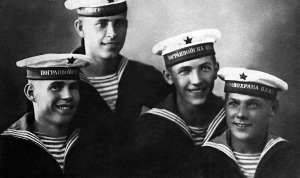
So they were in the summer of the 1941 of the year before being assigned to the floating battery. From left to right: Ivan Tigniverenko, Ivan Chumak, Dmitry Sivolap, Alexander Mikheev
Viktor Ilyich Samokhvalov, battery foreman 37-mm automata
Materials used:
Shurygin V. Anti-aircraft citadel
http://mywebs.su/blog/history/5669.html
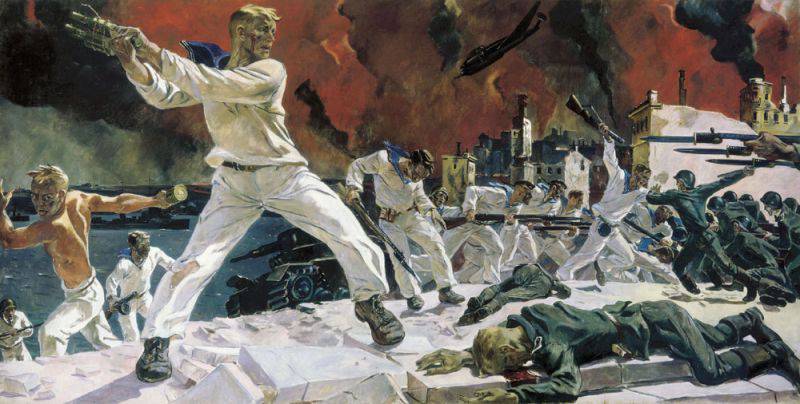
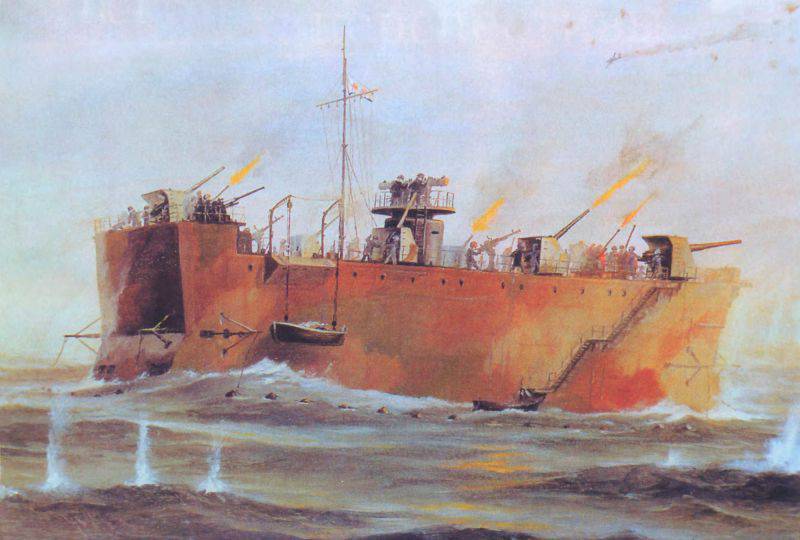
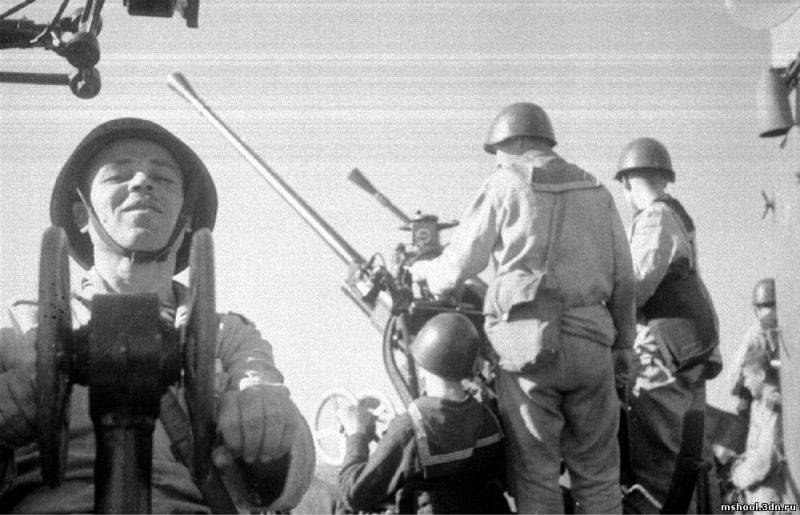
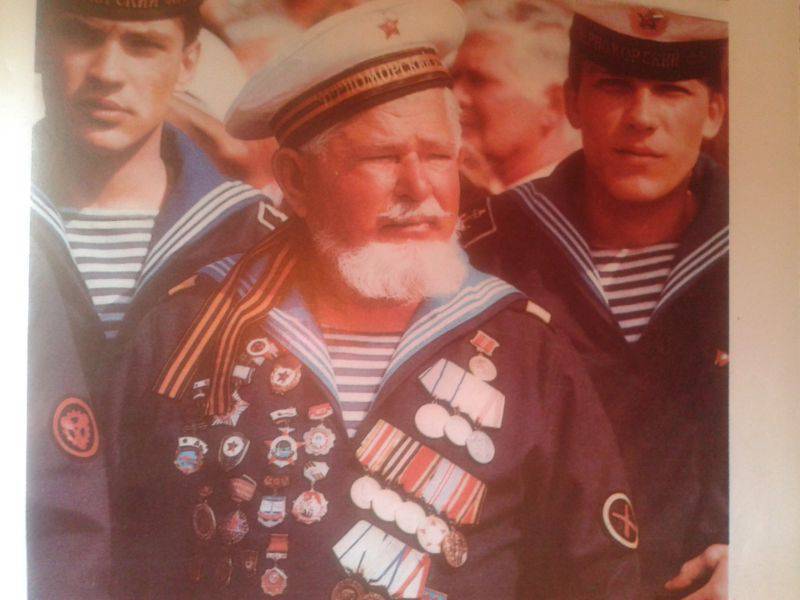
Information